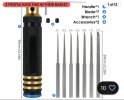jonte
Western Thunderer
I’d try and keep the bubbling/flaking paint effect, JanA Porky Prime Cut
(a nod to all those who ‘trainspotted’ 45 single runout grooves..)
A pair of Mica’s. X2, I believe. One was a eBay score, the right length, and described as kitbuilt. The other is the Hornby Dublo version. A stretch, on the reality front.
I’m pretty sure the eBay version is scratchbuilt; it was certainly heavily painted, and along with the accompanying wagons, had a lot of burrs. You can hopefully see this after it’s twenty minute bath in Phoenix Paints paint stripper.
The HD version MIGHT bear a cut and shut. IF it’s just a length issue….
The assembly was thick with UHU. The brake shoe assemblies (whitemetal) are very bendy. The 00 wheels have been removed, and the metal bits will be resubmitted to paint stripper. The body does not sit flat, as one of the solebars is too high at one end. And there’s a definite ‘bloat’ to the floor - which might preclude compensation. For all that, it’s an amazing bit of modelling that deserves some resurrection. I hope I can do it justice.
Cheers
Jan

You’re definitely made of better stuff than me for even attempting to resurrect such relics , if I may be so bold to say so…..
Good luck!
Jon













